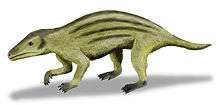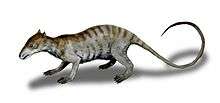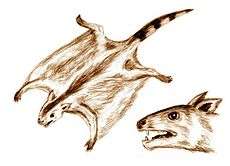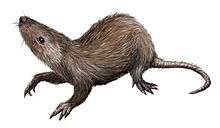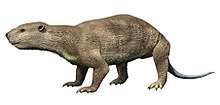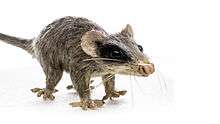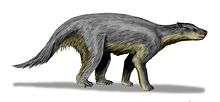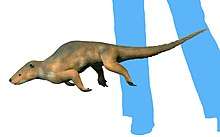Djadochtatherioidea
Djadochtatherioidea is a group of extinct mammals known from the upper Cretaceous of Central Asia. They were members of an also extinct order called Multituberculata. These were generally somewhat rodent-like creatures, who scurried around during the "age of the dinosaurs", though nonetheless very ecologically diverse; several were jerboa-like hoppers,[1] while others like Mangasbaatar were large sized and fossorial.[2] Unusually for multituberculates, some of this group are represented by very good remains. All upper Cretaceous Mongolian multituberculates are included with one exception, the genus Buginbaatar.
| Djadochtatherioidea Temporal range: Late Cretaceous | |
|---|---|
 | |
| Various skulls | |
| Scientific classification | |
| Kingdom: | Animalia |
| Phylum: | Chordata |
| Class: | Mammalia |
| Order: | †Multituberculata |
| Suborder: | †Cimolodonta |
| Superfamily: | †Djadochtatherioidea |
| Clades | |
This superfamily is further subdivided into two families and several other genera, as listed in the table. These djadochs are within the suborder of Cimolodonta. Djadochtatherioidea was established by Kielan-Jaworowska and Hurum in 2001 as a replacement for the previously proposed Djadochtatheria (Kielan-Jaworowska & Hurum, 1997).
References
- Meng Chen, Gregory Philip Wilson, A multivariate approach to infer locomotor modes in Mesozoic mammals, Article in Paleobiology 41(02) · February 2015 DOI: 10.1017/pab.2014.14
- Guillermo W. Rougier; Amir S. Sheth; Barton K. Spurlin; Minjin Bolortsetseg; Michael J. Novacek (2016). "Craniodental anatomy of a new Late Cretaceous multituberculate mammal from Udan Sayr, Mongolia" (PDF). Palaeontologia Polonica. 67: 197–248. doi:10.4202/pp.2016.67_197.
- Kielan-Jaworowska Z. & Hurum J.H. (2001), "Phylogeny and Systematics of multituberculate mammals." Paleontology 44, p. 389-429.
- Much of this information has been derived from MESOZOIC MAMMALS; Djadochtatherioidea, an Internet directory.

